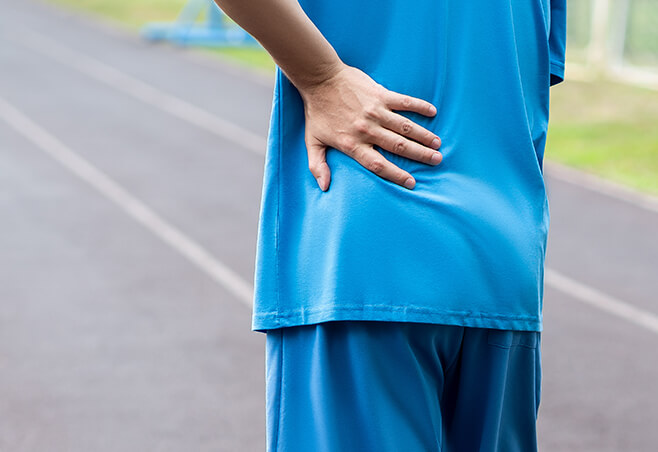Sports hernias
Athletic pubalgia
Despite its name, a sports hernia is not a hernia; it is a painful, soft tissue injury that occurs in a joint area and usually during vigorous sports that have sudden changes of direction or intense twisting motions. While it is not the same as a hernia, it does have many of the same symptoms. The most significant difference is that a sports hernia does not result in a groin bulge.
They can be treated both with surgical and nonsurgical procedures. Your Florida Orthopaedic Institute physician will help walk you through your options.
Anatomy
The soft tissues most frequently affected by sports hernias are the oblique muscles in the lower abdomen. The tendons that attach the oblique muscles to the pubic bone are the most vulnerable. In many sports hernias, the tendons that attach the thigh muscles to the pubic bone (adductors) can be stretched or torn.
About
A sports hernia is a painful, soft tissue injury that happens in an abdominal joint area. It most often happens during vigorous sports that have sudden changes of direction or intense twisting motions, such as ice hockey, soccer, football, and wrestling. The soft tissues that perform these movements in the lower abdomen and pubic area are most frequently torn or injured. The tendons that attach the oblique muscles to the pubic bone are especially vulnerable. In many sports hernias, the tendons that attach the thigh muscles to the pubic bone (adductors) are also stretched or torn.
Despite its name, a sports hernia is not a hernia. The condition’s actual name is athletic pubalgia. Although the symptoms are similar, the pain and pressure are caused by torn tendons attached to the pelvis. A traditional hernia (inguinal is abdominal muscle separation and protrusion of intestine or other soft tissue.
Symptoms
The main symptom of a sports hernia is severe pain in the groin area at the time of injury that gets better with rest but returns during the activity. This type does not cause a visible bulge in the groin, unlike the inguinal hernia – its more common counterpart.
Over time, a sports hernia can lead to an inguinal, and abdominal organs may press against the weakened soft tissues to form a visible bulge. For this reason, it is essential to get treatment as soon as possible.
Diagnosis
Your Florida Orthopaedic Institute physician will analyze your symptoms and ask how the injury occurred, followed by a physical examination. If you have a sports hernia, they will likely find tenderness in the groin or above the pubis during the exam. Although they may be associated with a traditional inguinal hernia, in most cases, a hernia can’t be found by the doctor during a physical examination.
After your physician completes a thorough exam, he or she may order X-rays or magnetic resonance imaging (MRI) scans to help determine whether you have a sports hernia. Occasionally, bone scans or other tests are recommended to rule out other possible causes of the pain.
Treatment
A sports hernia can be treated both surgical and nonsurgically, depending on the severity of your injury. Typically, nonsurgical treatments are recommended first. If they are ineffective, then your physician may consider surgical treatment options.
Nonsurgical treatments
There are three main nonsurgical things you can do to treat your sports hernia. They are:
- Rest – In the week after the injury, treatment with rest and ice can help relieve painful symptoms.
- Physical therapy – Typically, two weeks after your injury, you can begin to do physical therapy exercises to improve your abdominal and inner thigh muscles’ strength and flexibility.
- Anti-inflammatory medications – Your physician may recommend non-steroidal anti-inflammatory medicines such as Advil/Motrin (ibuprofen) or Aleve (naproxen) to reduce swelling and pain. If your symptoms persist over a prolonged period, your doctor may also suggest a cortisone injection (a very effective steroid anti-inflammatory medicine).
Surgical treatments
Surgery to repair the groin’s torn tissues can be done as a traditional, open procedure with one long incision or as an endoscopic procedure. In an endoscopy, the surgeon makes smaller skin incisions and uses a small camera, called an endoscope, to see inside the abdomen.
Some sports hernia cases require cutting a small nerve in the groin (the inguinal nerve) during the surgery to relieve the patient’s pain. This procedure is called an inguinal neurectomy.
Your Florida Orthopaedic Institute physician will help walk you through your options and determine which procedure is the best for you. Regardless of what is chosen, you will most likely have to go through a rehabilitation program after surgery to help you regain your strength and endurance.

Videos
Related specialties
- Anterior Hip Replacement
- Avascular Necrosis (Osteonecrosis)
- Groin Strains & Pulls
- Hamstring Injuries
- Hip Arthroplasty
- Hip Arthroscopy
- Hip Dislocation
- Hip Flexor Strains
- Hip Fractures
- Hip Hemiarthroplasty
- Hip Impingement Labral Tears
- Hip Muscle Strains
- Hip Pointers & Trochanteric Bursitis
- Iliopsoas Tenotomy
- Labral Tears of the Hip (Acetabular Labrum Tears)
- Osteoarthritis of the Hip
- Osteoporosis
- Pelvic Ring Fractures
- Piriformis Syndrome
- Thigh Fractures
- Thigh Muscle Strains
